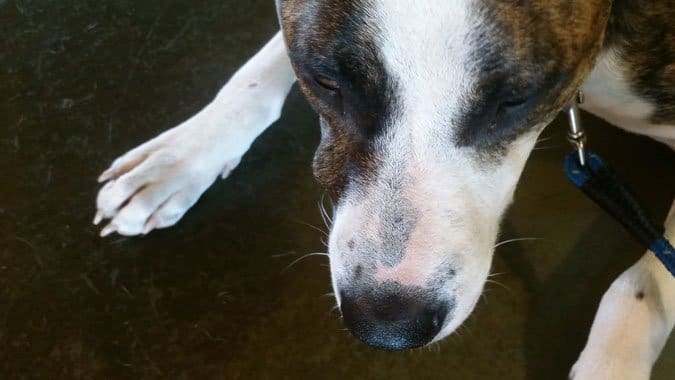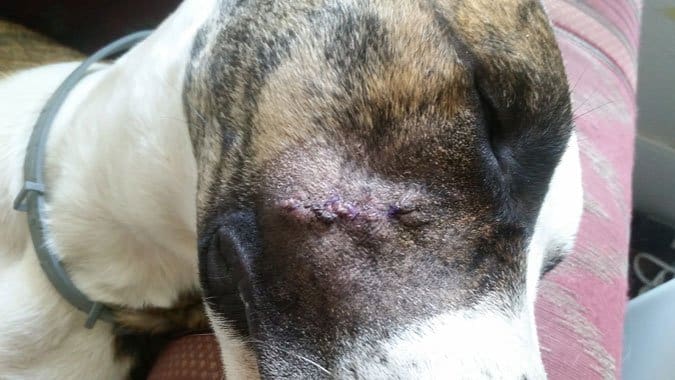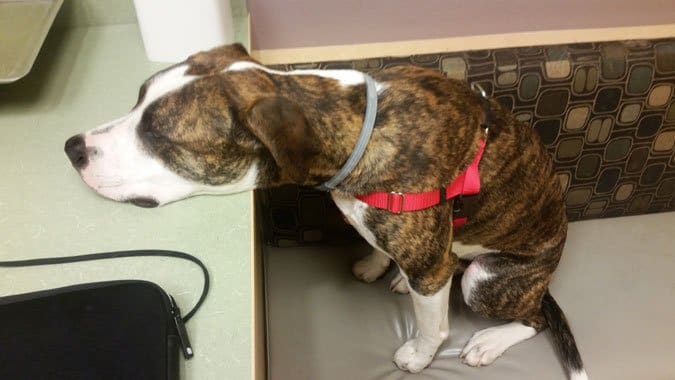To paraphrase Forrest Gump, life with dogs is like a box of chocolates; you never know what you are going to get.
In early May, my adolescent Pit/Lab-mix, Woody, started coughing and gagging dramatically. It seemed like he had something stuck in his throat, and though I looked in his mouth and throat I couldn’t see anything. It called for an immediate trip to the veterinarian.
With me holding Woody and a trained eye, the vet was immediately able to see the problem: Woody had some foxtails in his tonsils. This grassy plant is the bane of dogs in California; its long, pointed awns readily stick to flesh and start to travel inward, drawn by the microscopic projections on every surface of the filaments that trail the sharp seed. I’d guess that half the patients in the waiting room at the veterinary hospital were there for foxtails (in their paws, ears, and other places).
The vet put Woody under general anesthesia for a few minutes, and extracted the foxtails that she found in his tonsils, and more she found jammed into his gums around his farthest-back molars. He had evidently eaten a bunch of grass, probably in an effort to settle his tummy after getting into my chicken coop and eating a bunch of cracked grain. (I later found a poop in the back yard that was almost entirely undigested corn and other grains, and the upset-tummy/grass-gorging scenario is my best guess.)

About four days later, a huge lump appeared overnight on Woody’s cheek. Given the fact that the vet had just removed foxtails from Woody’s molars, I thought it entirely likely that he had another foxtail in his cheek, perhaps one that traveled from his upper gums. Back to the clinic. The vet agreed with my guess. She closely examined the outside of Woody’s cheek and the inside of his cheek and gums, and lanced the lump from inside, but couldn’t find the sort of entry hole or track that foxtails usually leave. He didn’t have a fever and there were no other signs of infection, so she said we should just watch the lump for a while.
While I was watching Woody’s lump, I noticed that Otto had developed a slight cough. Oh my goodness.
It wasn’t the gagging cough that Woody had displayed when he had the foxtails in his throat, but it was persistent. Back to the vet we went.
The vet looked in Otto’s mouth and throat and listened to Otto’s lungs carefully, but couldn’t see or hear anything amiss – and of course he didn’t cough while we were there. She suggested a “senior panel” – a very extensive blood test that would give us more information about his general health. Given that we live in heartworm country, even though Otto has been on heartworm preventive medications, I felt good that the blood test included a heartworm test.
The heartworm test was negative, and his other blood test results were unremarkable. More watching and waiting.
About a week later, with Woody’s lump still quite large and Otto’s cough getting worse, we went back to the vet.
A different vet saw Woody. He aspirated some fluid from the lump and said it was full of pus. He thought it was likely there was a piece of foxtail in the lump, after all, and recommended cutting into the lump and exploring it. As it turned out, he never found a piece of foxtail, but removed the tissue inside the lump and sent some of the material to a pathologist. The final diagnosis was panniculitis: inflamed tissue likely caused by trauma. Given that Woody plays hard with his dog friends, the idea that he knocked his face on the corner of a coffee table or something made perfect sense.

As for Otto, this time I was prepared: Because he hadn’t coughed for the vet in our last visit, I had spent the week grabbing my cell phone and attempting to record every instance of Otto’s cough. I had a few examples ready to show the vet. Of course, this time, he coughed for the vet as if I had trained him to do so. His lungs still sounded clear, however.
Diagnostics this time: An x-ray of his chest and an abdominal ultrasound, looking for any masses and checking to make sure his organs all looked like they were the right size and in the right place. Everything looked normal except there was one surprise: the x-rays revealed a pattern that suggested Otto had pneumonia in one lobe of his right lung. It was surprising in that he had no fever and no other symptoms (such as crackly-sounding lungs), just the cough. One theory we are considering: perhaps Otto has a small amount of laryngeal paralysis, common enough in older dogs, and he aspirated some water while drinking or swimming, and this set the stage for the pneumonia to develop. The vet recommended a two-week course of an antibiotic (Clavamox) and a follow-up x-ray.
The Clavamox made absolutely no difference in his cough, and the follow-up x-rays looked even worse. The veterinarian recommended a bronchoscopy – under full anesthesia, putting a flexible instrument with a camera down his throat and into the lung, looking for anything unusual. (This would also help determine whether some laryngeal paralysis was present.) Most helpfully, the instrument can also send tiny bits of saline solution into the parts of his lungs that look inflamed and then suck the fluid back up, thus gathering some cells that can be cultured (a bronchial lavage). This could help us identify exactly what is causing the pneumonia and tailor an antibiotic regiment to the culprit. The only problem was, the next day the procedure could be scheduled was the day before I was leaving for an out-of-state vacation. I didn’t feel comfortable leaving Otto after such a serious procedure; I wanted to be able to watch him for any potential, subtle signs of adverse effects from the procedure (the lung can get punctured and greater infections and problems can result).
Instead, we opted for Plan B: another course of antibiotics, but this time, using one of the “big guns” – a strong, broad-spectrum antibiotic called Baytril. Otto could take the antibiotic while I was gone (he stayed with my sister and her husband), and we’d follow up with another x-ray at the end of two weeks.

The follow-up x-ray, thank goodness, looked better, though not completely clear of the inflammation caused by pneumonia. The vet extended Otto’s prescription for another week, and we’ll take another x-ray when this course of antibiotics is complete. If there is still inflammation, we may well do the bronchoscopy and bronchial lavage, after all.
Three vet visits for Woody, five so far for Otto, with more to come . . . getting a good pet insurance policy was the best thing I did last year. It has given me so much peace of mind to know that whatever tests we need to run, or what medicines are prescribed (that Baytril is expensive!), I can easily afford it. The plan I signed both dogs up for is called Whole Pet with Wellness, offered by Nationwide (formerly VPI). I pay $58 a month for Woody, and $122 for Otto. After a $250 a year deductible for each dog, the policy pays for 90 percent of each allowed veterinary bill my dogs have incurred. We blew through the deductible in the first visit for each dog – but that means that I pay only 10 percent of each bill for the rest of the year. That means I’m breathing much more easily, and, I hope, so will Otto. I’ve heard him cough just once in the past week, and we will return to the vet for another follow-up x-ray later this week.







